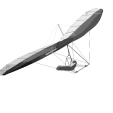New Zealand – South Island
Site Information
Coronet Peak is the main flying site at Queenstown, New Zealand. It offers stunning views of the surrounding mountains and lakes, and is suitable for both paragliding and hang gliding. There are two main takeoffs: The Carpark and Rocky Gully.
The Carpark is located at the top of the ski field access road, at an altitude of about 1200 meters. It faces south-east and is good for light to moderate winds from that direction. It has a large grassy area for setting up and launching, and a gentle slope for landing.
Rocky Gully is located about 2 km further up the dirt road from the Carpark, at an altitude of about 1650 meters. It faces south-west and is good for moderate to strong winds from that direction. It has a smaller grassy area for setting up and launching, and a steeper slope for landing.
The main landing area is the Flight Park, located on the north side of Malaghans Road towards Arrowtown, at an altitude of about 350 meters. It has a large flat field with windsocks and a toilet. There is also a cafe and a shop where you can buy drinks and snacks.
The coordinates of the launch and landing areas are:
- The Carpark: -44.9383, 168.7578
- Rocky Gully: -44.9317, 168.7622
- Flight Park: -44.9567, 168.7983
Flying Conditions and Restrictions
Coronet Peak is a dynamic and challenging site that requires good flying skills and local knowledge. It is not recommended for beginners or low airtime pilots. The site is subject to strong thermals, turbulence, wind shear, and valley winds that can change rapidly. Pilots should always check the weather conditions before flying and consult with local pilots or instructors.
The site is also subject to strict airspace restrictions due to the proximity to Queenstown airport. The airspace, G755, is a General Aviation area located within the Queenstown Tower Control Zone. The ceiling is 5500 feet AMSL. Pilots must not fly south of Malaghans Road, west of the hairpins on the Coronet access road, or east of the forestry block ridge. Pilots must also carry a radio and contact Queenstown Tower on 118.1 MHz before launching and after landing.
Pilots must respect the rules and regulations of the Southern Hang Gliding and Paragliding Club (SHGPC), which manages the site. Pilots must be members of the club or pay a $10 visitor fee per day. Pilots must also have a current NZHGPA membership or a valid IPPI card. Pilots must follow the site briefing and code of conduct, which are available on the SHGPC website. Pilots must also respect the landowners and other users of the site, such as skiers, hikers, bikers, and wildlife.
Best Times to Fly and Visit
Coronet Peak is open for flying all year round, weather permitting. However, the best times to fly and visit depend on your preferences and goals.
If you want to experience the thrill of flying from the highest takeoff in Queenstown, you should visit during the summer months (December to February), when the summit of Coronet Peak is accessible by a dirt road. The summer flying conditions are generally more stable and smooth, with light to moderate winds and thermals. The summer season also offers longer daylight hours and warmer temperatures.
If you want to combine flying with skiing or snowboarding, you should visit during the winter months (June to September), when the ski field is operating. The winter flying conditions are generally more dynamic and challenging, with moderate to strong winds and turbulence. The winter season also offers the opportunity to fly at night, as Coronet Peak is the home of Night Skiing on Wednesday, Friday and Saturday nights.
If you want to avoid the crowds and enjoy the scenery, you should visit during the shoulder seasons (March to May and October to November), when the tourist numbers are lower and the nature is changing. The autumn and spring flying conditions are generally more variable and unpredictable, with changing winds and weather patterns. The autumn and spring seasons also offer the chance to see the stunning colours of the foliage and the snow-capped peaks.
Coronet Peak has hosted some record flights in the past, such as a 222 km out-and-return flight by Louis Tapper in 20101. However, these flights are rare and require exceptional skills and conditions. Most pilots enjoy flying locally around Coronet Peak and exploring the nearby valleys and ridges.
More Information
If you need more information about Coronet Peak, you can visit the following websites or contact the following numbers:
- Coronet Peak Ski Area: The official website of the ski field, where you can find information about the mountain, the facilities, the events, the snow report, and the online shop. You can also book your lift passes, rentals, lessons, and transport online. The website also has a live webcam and a weather forecast for Coronet Peak.
- NZSki: The parent company of Coronet Peak, The Remarkables, and Mt Hutt ski areas. The website has information about all three ski fields, as well as deals and packages for skiing in New Zealand.
- Southern Hang Gliding and Paragliding Club: The club that manages the flying site at Coronet Peak. The website has information about the club, the site briefing, the code of conduct, the membership fees, and the visitor fees. The website also has a forum where you can chat with other pilots and get updates on the flying conditions.
The phone numbers for Coronet Peak are:
- Guest Services: +64 3 442 4628
- Administration: +64 3 442 4615
- Snow Report: +64 3 450 1970
- Queenstown Tower: 118.1 MHz
I hope this site guide helps you plan your visit to Coronet Peak. Have a great time flying and enjoy the views!













